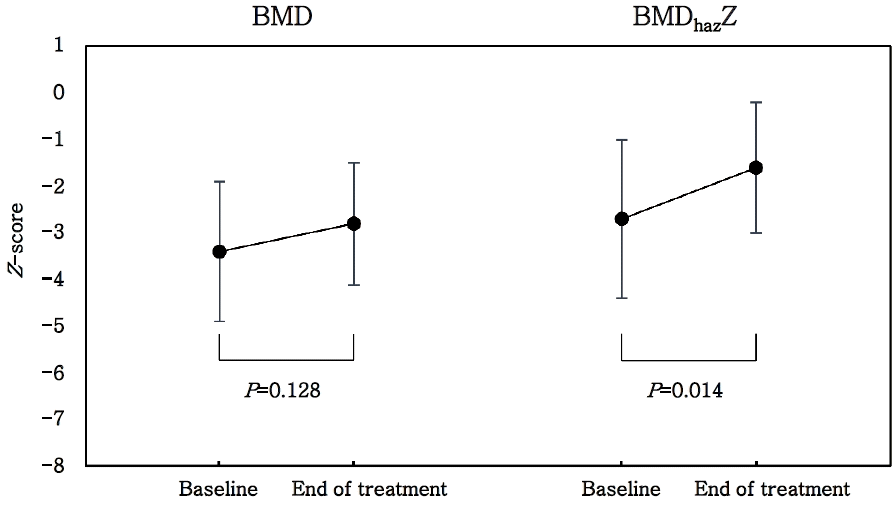1. Bishop N, Arundel P, Clark E, Dimitri P, Farr J, Jones G, et al. Fracture prediction and the definition of osteoporosis in children and adolescents: the ISCD 2013 Pediatric Official Positions. J Clin Densitom. 2014; 17:275–80.

2. Compston JE, McClung MR, Leslie WD. Osteoporosis. Lancet. 2019; 393:364–76.

3. Henderson RC. Bone density and other possible predictors of fracture risk in children and adolescents with spastic quadriplegia. Dev Med Child Neurol. 1997; 39:224–7.

4. Lee JJ, Lyne ED. Pathologic fractures in severely handicapped children and young adults. J Pediatr Orthop. 1990; 10:497–500.

5. Song K, Kwon A, Chae HW, Suh J, Choi HS, Choi Y, et al. Vitamin D status is associated with bone mineral density in adolescents: findings from the Korea National Health and Nutrition Examination Survey. Nutr Res. 2021; 87:13–21.

6. Henderson RC, Lark RK, Gurka MJ, Worley G, Fung EB, Conaway M, et al. Bone density and metabolism in children and adolescents with moderate to severe cerebral palsy. Pediatrics. 2002; 110:e5.

7. Berger C, Goltzman D, Langsetmo L, Joseph L, Jackson S, Kreiger N, et al. Peak bone mass from longitudinal data: implications for the prevalence, pathophysiology, and diagnosis of osteoporosis. J Bone Miner Res. 2010; 25:1948–57.

8. Golden NH, Abrams SA, Committee on N. Optimizing bone health in children and adolescents. Pediatrics. 2014; 134:e1229–43.

9. Weaver CM, Gordon CM, Janz KF, Kalkwarf HJ, Lappe JM, Lewis R, et al. The National Osteoporosis Foundation's position statement on peak bone mass development and lifestyle factors: a systematic review and implementation recommendations. Osteoporos Int. 2016; 27:1281–386.

10. Bachrach LK, Ward LM. Clinical review 1: bisphosphonate use in childhood osteoporosis. J Clin Endocrinol Metab. 2009; 94:400–9.
11. Camacho PM, Petak SM, Binkley N, Diab DL, Eldeiry LS, Farooki A, et al. American Association of Clinical Endocrinologists/American College of Endocrinology Clinical Practice Guidelines for the diagnosis and treatment of postmenopausal osteoporosis-2020 update. Endocr Pract. 2020; 26:1–46.

12. Glorieux FH, Bishop NJ, Plotkin H, Chabot G, Lanoue G, Travers R. Cyclic administration of pamidronate in children with severe osteogenesis imperfecta. N Engl J Med. 1998; 339:947–52.

13. Henderson RC, Lark RK, Kecskemethy HH, Miller F, Harcke HT, Bachrach SJ. Bisphosphonates to treat osteopenia in children with quadriplegic cerebral palsy: a randomized, placebo-controlled clinical trial. J Pediatr. 2002; 141:644–51.

14. Grissom LE, Kecskemethy HH, Bachrach SJ, McKay C, Harcke HT. Bone densitometry in pediatric patients treated with pamidronate. Pediatr Radiol. 2005; 35:511–7.

15. Moon SJ, An YM, Kim SK, Kwon YS, Lee JE. The effect of low-dose intravenous bisphosphonate treatment on osteoporosis in children with quadriplegic cerebral palsy. Korean J Pediatr. 2017; 60:403–7.

16. Yoon JH, Choi Y, Lee Y, Yoo HW, Choi JH. Efficacy and safety of intravenous pamidronate infusion for treating osteoporosis in children and adolescents. Ann Pediatr Endocrinol Metab. 2021; 26:105–11.

17. Bachrach SJ, Kecskemethy HH, Harcke HT, Hossain J. Decreased fracture incidence after 1 year of pamidronate treatment in children with spastic quadriplegic cerebral palsy. Dev Med Child Neurol. 2010; 52:837–42.

18. Simm PJ, Biggin A, Zacharin MR, Rodda CP, Tham E, Siafarikas A, et al. Consensus guidelines on the use of bisphosphonate therapy in children and adolescents. J Paediatr Child Health. 2018; 54:223–33.

19. Kim JH, Yun S, Hwang SS, Shim JO, Chae HW, Lee YJ, et al. The 2017 Korean National Growth Charts for children and adolescents: development, improvement, and prospects. Korean J Pediatr. 2018; 61:135–49.

20. Munns CF, Shaw N, Kiely M, Specker BL, Thacher TD, Ozono K, et al. Global consensus recommendations on prevention and management of nutritional rickets. J Clin Endocrinol Metab. 2016; 101:394–415.
21. Zemel BS, Leonard MB, Kelly A, Lappe JM, Gilsanz V, Oberfield S, et al. Height adjustment in assessing dual energy x-ray absorptiometry measurements of bone mass and density in children. J Clin Endocrinol Metab. 2010; 95:1265–73.

22. Rolvien T, Amling M. Disuse Osteoporosis: clinical and mechanistic insights. Calcif Tissue Int. 2022; 110:592–604.

23. Leblanc AD, Schneider VS, Evans HJ, Engelbretson DA, Krebs JM. Bone mineral loss and recovery after 17 weeks of bed rest. J Bone Miner Res. 1990; 5:843–50.

24. Qin L, Liu W, Cao H, Xiao G. Molecular mechanosensors in osteocytes. Bone Res. 2020; 8:23.

25. Pack AM. Bone disease in epilepsy. Curr Neurol Neurosci Rep. 2004; 4:329–34.
26. Henderson RC. Vitamin D levels in noninstitutionalized children with cerebral palsy. J Child Neurol. 1997; 12:443–7.

27. Plotkin H, Coughlin S, Kreikemeier R, Heldt K, Bruzoni M, Lerner G. Low doses of pamidronate to treat osteopenia in children with severe cerebral palsy: a pilot study. Dev Med Child Neurol. 2006; 48:709–12.

28. Mallmin H, Ljunghall S, Larsson K, Lindh E. Short-term effects of pamidronate on biochemical markers of bone metabolism in osteoporosis--a placebo-controlled dosefinding study. Ups J Med Sci. 1991; 96:205–12.

29. Li P, Zhao Z, Wang L, Jin X, Shen Y, Nan C, et al. Minimally effective concentration of zoledronic acid to suppress osteoclasts in vitro. Exp Ther Med. 2018; 15:5330–6.





 PDF
PDF Citation
Citation Print
Print



 XML Download
XML Download